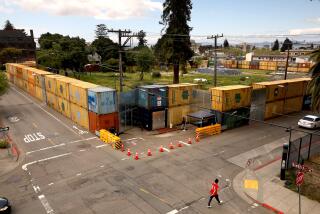The AQMD: A Political Creature Suffers a Political Fate
VENTURA — The recent resignations of nine scientists from an advisory panel at the South Coast Air Quality Management District are an important reminder that environmental protection is more politics than science. Moreover, the way the AQMD is constituted--a big, centralized agency governed by political appointees--makes it acutely sensitive to political pressure.
The mass exodus surprised everyone. In a joint letter, eight of the departing scientists complained that the AQMD’s new anti-smog plan was drafted without their support and that “the district is embarked on a course that will not lead to attainment of federal ozone and fine-particle standards.”
The most revealing aspect of the incident, however, was the reaction to it, which constituted little more than politics-as-usual. Riverside County Supervisor Kay Ceniceros, an AQMD board member generally supportive of strong environmental protection, said the advisors represented “an extraordinarily valid point of view,” adding: “We need those scientists to be our conscience.” By contrast, state Sen. Raymond N. Haynes (R-Temecula), who defeated Ceniceros for his Senate seat in 1994, claimed that the scientists served no purpose because, “What is supposed to be . . . objective science is actually highly politicized interpretations of a political agenda.”
In other words, why the scientists resigned or what they were concerned about hardly matters. Their departure didn’t seem to make anybody think twice--or even once--about anything. Instead, the scientists were pawns to buttress pro-forma views about environmental regulation.
There’s an enduring myth in U.S. government that disputes over environmental protection can be resolved by “good science.” If we just let our scientists loose on the problem, the theory goes, “good science” will reveal the truth. Answers will pop into bold relief; and we will know what to do. The scientists will show us the way.
Actually, when enough scientific brainpower is applied to an environmental problem over a long enough period, answers usually do emerge. But this doesn’t have much to do with the politics of environmental protection.
The South Coast Air Quality Management District exists mostly because of the federal Clean Air Act, a law originally passed in 1970 and most recently amended in 1990. As such, the Southland’s smog-fighting efforts function mostly as an exercise in political will--and political will changes from week to week, and from year to year.
The Clean Air Act laid down federal standards and required all metropolitan areas to comply with them by 1977. This deadline proved unrealistic--at least by the political standards of the mid-1970s, a period in U.S. history marked by economic instability.
Meeting the deadline was theoretically possible--that is, it was scientifically possible--but it would have required too much economic disruption, or so the politicians believed. So regulations were rewritten and deadlines were pushed back, again and again. Under the most recent amendments to the Clean Air Act, Los Angeles has until 2020 to meet federal standards--meaning Angelenos have been given a grace period of 43 years, so far.
The AQMD’s history tells a similar story. During the boom years of the 1980s, environmentalists, federal bureaucrats, staff members and the public prodded the agency to get tougher on pollution. James Lents, a Tennessee chemist with a no-compromise reputation, took over and declared Los Angeles to be “the Super Bowl of smog.” The AQMD ran its computer models for every possible way to reduce air-pollution emissions; hence, the AQMD’s controversial car-pooling requirement for large employers and its often ridiculed ban on the sale of charcoal-lighter fluid.
When recession hit in the early 1990s, political tolerance for anti-smog regulations changed. Though Lents remained in charge, his agency became more flexible, rolling back many regulations. The business community, which had long complained about the anti-smog power wielded by the agency, recognized that this was a two-way street.
Throughout, the Clean Air Act did not change. Neither did the technology used to fight smog, nor the computerized-modeling approach used by most air-quality analysts, nor the weather patterns that make Los Angeles susceptible to smog. All that had changed was the political climate. The technical advisors, focused on “good science,” became irrelevant to the discussion.
Ironically, the scientists’ departure may have come at a time when the political winds show signs of changing again. Former state Sen. Robert Presley, who represented smoggy Riverside for many years, asserted after the resignations: “Their timing is sort of bad. We’re coming out of the recession, to where the board would probably feel more comfortable making a more hard-line stance against air pollution.” Presley, who advocated strong anti-smog legislation, understood what the scientists did not--that environmental protection is ultimately a political equation, not a scientific one.
But politics is not inevitably hazardous to public health. Since the Clean Air Act first passed, millions of people, millions of vehicles and thousands of businesses have been added to the metropolis--and the air in Los Angeles is significantly better than it used to be. Furthermore, many jobs in “dirty” industries have left town because of anti-smog regulations, but important gains in air quality have been realized. All this has occurred because, more often than not, the political equation has favored stronger anti-pollution regulation.
It may be that Los Angeles will never meet federal air-quality goals--even if Congress gives us another 43 years to comply. But future progress is likely--and it will depend far more on politics than on science.
More to Read
Sign up for Essential California
The most important California stories and recommendations in your inbox every morning.
You may occasionally receive promotional content from the Los Angeles Times.










